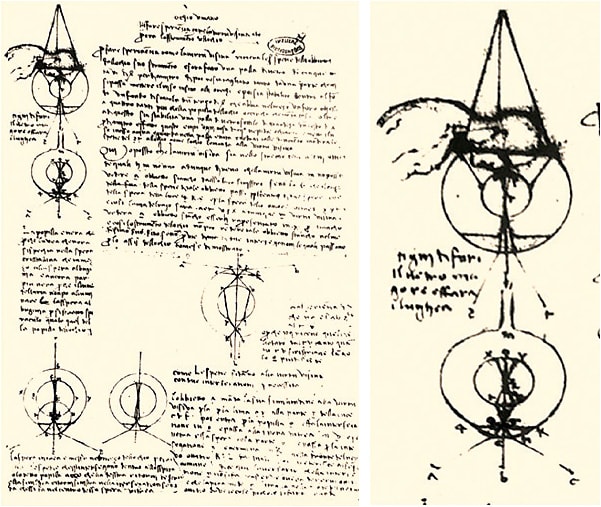There is an old saying…“People make history...but in recording the events, authors sometimes rewrite history.” Unfortunately, the history of contact lenses has not escaped this confusion and controversy. Historical documents from the 12th to 17th centuries contain many diagrams illustrating various concepts related to optical systems (most often telescopes and microscopes) that have been misinterpreted as contact lenses.
Nowhere is that more evident than in the writings and sketches of artist and inventor, Leonardo da Vinci; in fact, he is often credited with the invention of contact lenses. This confusion emanates from the sketches and text found in da Vinci’s Manuscripts D Folio 3V and Folio 7V, circa 1513 to 1516.
Misinterpreted Manuscript
In Manuscript D Folio 3V, the sketches show a cup-shaped vessel placed in front of the face (Figure 1). The head appears to be plunged into a suspended spherical bowl, presumably filled with water. Authors have theorized that the sketches demonstrated how irregularities of the corneal surface might be neutralized.

However, it was the French ophthalmologist Robert Heitz, MD, PhD, in 2003, who painstakingly reviewed the text and drawings of the original da Vinci manuscripts. Heitz discovered that the images were not illustrating the neutralization of refractive power, but rather described a theory as to how images were formed from the cornea to the optic nerve. In the text surrounding the images, da Vinci explains why images are perceived as erect, even though optically they are inverted. He goes on to suggest that inversion of the image occurs twice—once at the pupillary plane and then again at the crystalline lens; da Vinci did not consider the cerebral reversal of the image.
The second controversial da Vinci sketch takes place in Manuscript D Folio 7V (Figure 2). The image appears to demonstrate the neutralization of optical power by means of immersion of the eye in a liquid. However, as Heitz explains, “the sketch actually illustrates the erroneous uveal theory related to the inversion of an image by reflection on the concave ‘mirror’ of the uvea.”

Revising Assumptions
As is often the case, contemporary authors have made two primary errors in their interpretations. First, they have not thoroughly studied the original manuscripts, but rather relied on their predecessors’ writings. Second, they interpreted the writings and drawings based on our current knowledge of human anatomy and physiology rather than in the context of that time. Therefore, there is no proof that da Vinci ever conceived the concept of correcting eyesight with a lens placed directly onto the eye’s anterior segment.
While every scientific and medical discipline would love to trace its lineage back to da Vinci, historical evidence has shown that the discovery of the contact lens would have to wait several centuries. CLS
For references, please visit www.clspectrum.com/references and click on document #291.




